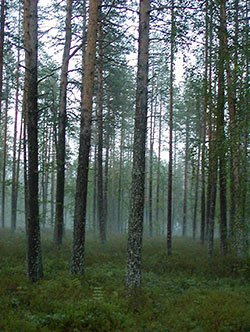
 UC Merced Professor Carolin Frank is helping figure out how a certain bacteria helps promote healthy tree growth by studying the bacteria’s genome sequence.
UC Merced Professor Carolin Frank is helping figure out how a certain bacteria helps promote healthy tree growth by studying the bacteria’s genome sequence.
In the new paper, published in the open-access journal mBio, Frank and research colleagues in Finland said their discoveries could have practical applications in agriculture and forestry by stimulating plant growth.
While trying to grow pine tree cells in petri dishes, the Finnish researchers couldn’t get rid of the Methylobacterium extorquens microbe. They were surprised to find the bacterium collecting inside the tree’s cells, especially around the nuclei.
And they found that inoculating the pine seedlings with the bacteria made the little trees grow faster, suggesting the bacteria are beneficial. That made Frank want to unveil the mechanisms behind the host-microbe interaction.
She and her colleagues were thrown another curveball when they found that some of the bacteria’s genes look more like eukaryotic than bacterial genes.
Plants are eukaryotes, and it is possible the bacterium makes these proteins so they can work with the plant’s machinery for protein synthesis, affecting plant growth from within the cells themselves, Frank said. Instead of producing plant hormones like some endophytes do, the microbes seem to transfer growth-supporting proteins into the tree cells’ nuclei.
“We usually don’t think about endophytic bacteria as intracellular, but it might be that we just haven’t looked enough,” she said. “I like to get a new perspective on questions, and maybe we just need to look from all the different angles.”
Now that the researchers have found this novel niche for endophytes, they will sequence other bacteria they’ve found in the Scots pine stem cells and study the symbiosis between the trees and their bacteria.
The genome sequencing was completed at the Department of Energy’s Joint Genome Institute in Walnut Creek, where UC Merced researchers are forging numerous collaborations. Frank said graduate students can apply to work on summer projects there, as well, giving them a unique opportunity.
This isn’t Frank’s first foray into tree endophytes. She works on a bacterial inventory in Colorado and California conifers with fellow Sierra Nevada Research Institute researcher Lara Kueppers. She’s also trying to get a better understanding of the microbes that fix nitrogen inside plants, which could help reduce fertilizer use and improve forecasts about climate change.
Frank, a computational biologist, started out researching bacterial pathogens in humans and animals in Sweden, where she’s from.
“It’s funny, because Finland and Sweden are covered with conifers, but I didn’t start studying trees until I came here,” Frank said.
Lorena Anderson

Senior Writer and Public Information Representative
Office: (209) 228-4406
Mobile: (209) 201-6255






